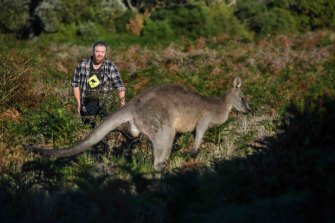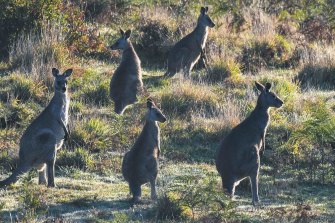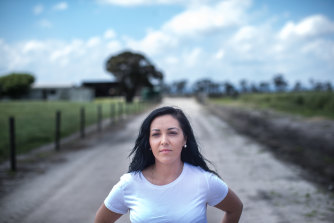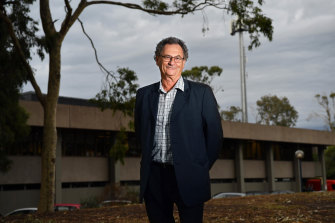Kangaroo shooting raises protest on Mornington Peninsula
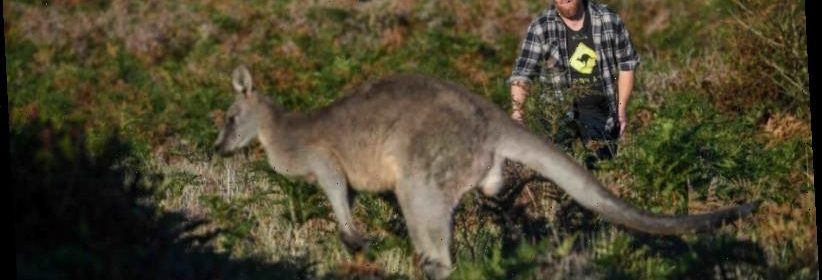
Controversial shooting of kangaroos on the Mornington Peninsula has sparked a local backlash amid fears the culls may lead to the animals being eradicated from the region.
Some Victorian landowners regard kangaroos as pests that damage agricultural land but many environmentalists argue the animal on Australia’s national emblem should be protected, not hunted.
Rye resident and wildlife protection activist Craig Thomson wants kangaroos protected from shooting on the Mornington Peninsula. Credit:Joe Armao
The state government insists its control of kangaroo numbers is humane and ecologically sustainable, saying their numbers have risen significantly since 2018.
But now there is a growing push for Mornington Peninsula kangaroos to be reclassified as part of Melbourne rather than Gippsland so they cannot be harvested.
Rye wildlife rescuer and former president of the Australian Wildlife Protection Council, Craig Thomson, said the peninsula holds a small number of kangaroos that are vulnerable to shooting, bushfires and diseases.
“We could lose the kangaroo population on the peninsula altogether,” he said.
Mr Thomson insisted there was no reliable count of the Mornington Peninsula’s kangaroos, arguing their inclusion in Gippsland distorts the figures.
“The idea is to get the community together and use citizen science to undertake kangaroo population surveys and get a better estimate of numbers and understand their behaviour as well.”
Apart from kangaroo harvesting, the Mornington Peninsula is officially classified as an area of Melbourne despite farmers arguing it should be recognised as part of regional Victoria. During last year’s coronavirus lockdown it was subject to the same restrictions as metropolitan Melbourne.
Freedom-of-information documents show in 2020 the Environment Department issued about a dozen permits allowing for more than 300 kangaroos to be shot on the peninsula. But the actual number may fall short of that figure.
A mob of kangaroos at Cape Schanck on the Mornington Peninsula. Credit:Joe Armao
A total of 17,250 kangaroos may be culled in the Gippsland region this year, which includes the government’s harvest program and permits for private properties.
A state government spokeswoman said the number of kangaroos “controlled” was closely monitored in each region.
“This number is determined by an aerial count conducted by experienced operators,” she said.
“The results of this count are combined with other information such as rainfall data, the age and sex ratio of the animals and information about how far kangaroos move around the landscape.”
Victorian Farmers Federation president Emma Germano.Credit:Simon Schluter
Victorian Farmers Federation president Emma Germano said the agriculture sector had to co-exist sustainably with wildlife. But she said high kangaroo numbers in some parts of the state meant they were running out of food.
“People have to understand in some areas kangaroos are in plague proportions,” she said.
Mornington Peninsula councillor David Gill has been pushing to stop kangaroo culling and recently moved a successful motion seeking more information about local Eastern Grey populations.
“We’re losing our wildlife on the Mornington Peninsula,” he said. “When I was a kid we had emus. Wombats were everywhere.”
Mornington Peninsula councillor David Gill wants local kangaroos protected from culling. Credit:Joe Armao
Most kangaroo shooting permits for the Mornington Peninsula ban the sale of kangaroo carcasses.
But the debate comes against the backdrop of new rules introduced by the Andrews government this year allowing kangaroo harvesting for human consumption for the first time in Victoria.
Sustainable harvesting is set at 10 per cent annually and the Arthur Rylah Institute for Environmental Research recommends a quota of 191,200 kangaroos.
The institute’s latest survey found that the state’s eastern grey kangaroo population had increased by 40 per cent since 2018, while the western grey kangaroo population had grown by 12 per cent.
Ray Borda, the national president of the Kangaroo Industry Association of Australia, said many concerns about the industry were unfounded.
“No one likes the idea of killing an animal,” he said. “But when they investigate, they will see kangaroos live a long life, they are in their natural habitat when they are killed and they are in abundance. We have nothing to hide.”
About 18 years ago, the Kangaroo Industry Association of Australia toyed with the idea of rebranding the meat as “Australus” following a public competition.
“The thinking was you don’t call deer meat deer meat, you call it venison, and you don’t call pig meat pig meat, you call it pork,” Mr Borda explained. “In the end we decided to stick with kangaroo. We didn’t want to hide the fact that we are selling kangaroo.”
Start your day informed
Our Morning Edition newsletter is a curated guide to the most important and interesting stories, analysis and insights. Sign up here.
Most Viewed in National
From our partners
Source: Read Full Article

